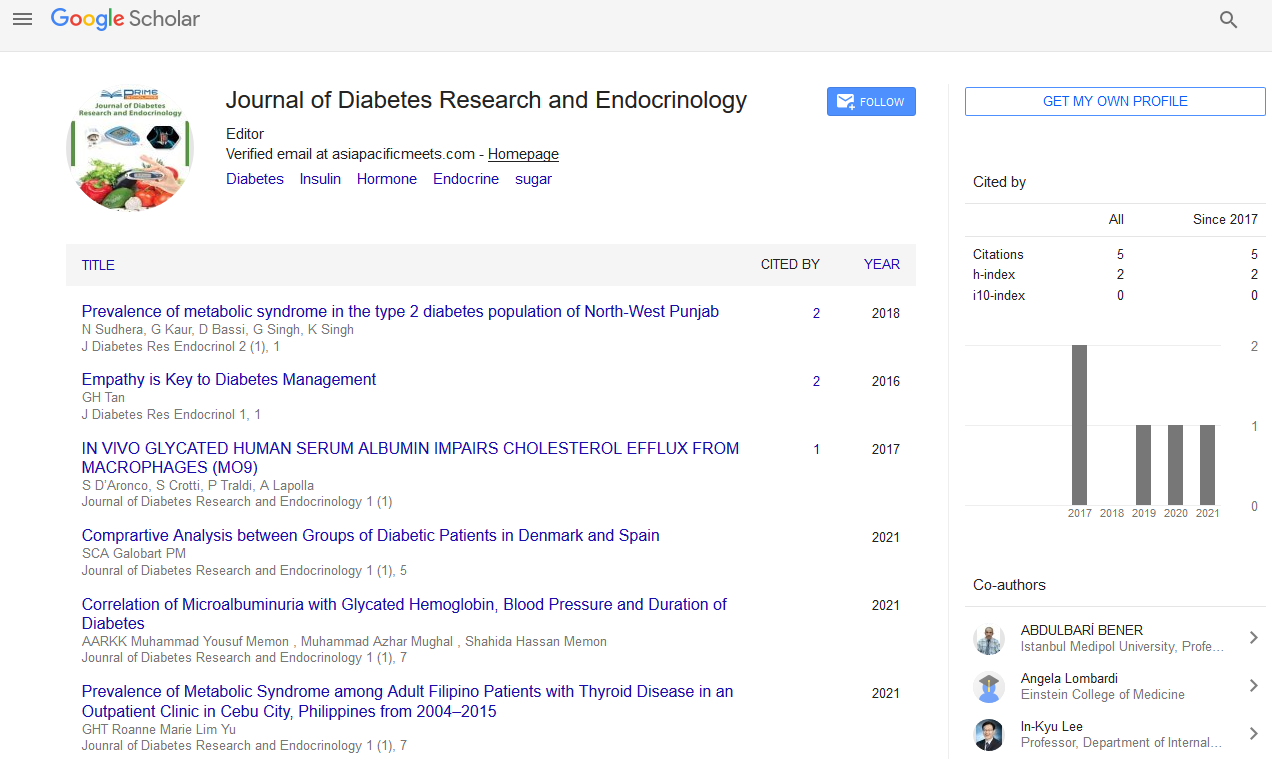Perspective - (2022) Volume 6, Issue 3
The Diabetes is a Chronic, Metabolic Disorder Characterised through Improved
Tiers of Blood Glucose.
Giuseppe Pugliese*
1Department of Endocrinology, University of Cambridge, United Kingdom
*Correspondence:
Giuseppe Pugliese, Department of Endocrinology, University of Cambridge,
United Kingdom,
Email:
Received: 02-May-2022, Manuscript No. IPJDRE -22-13563 ;
Editor assigned: 04-May-2022, Pre QC No. IPJDRE -22-13563 (PQ);
Reviewed: 18-May-2022, QC No. IPJDRE -22-13563 ;
Revised: 23-May-2022, Manuscript No. IPJDRE -22-13563 (R);
Published:
30-May-2022, DOI: 10.36648/IPJDRE.6.3.16
Introduction
Diabetes mellitus refers to a set of illnesses that have an effect
on how your frame makes use of blood sugar (glucose).
Glucose is critical in your fitness due to the fact it is an vital
supply of electricity for the cells that make up your muscular
tissues and tissues. It’s additionally your brain’s principal
supply of fuel. Diabetes mellitus (DM) is a metabolic disease,
concerning inappropriately increased blood glucose tiers. DM
has numerous categories, which includes kind 1, kind 2, maturity-
onset diabetes of the young (MODY), gestational diabetes,
neonatal diabetes, and secondary reasons because of endocrinopathies,
steroid use, etc. The principal subtypes of DM are
Type 1 diabetes mellitus (T1DM) and Type 2 diabetes mellitus
(T2DM), which classically end result from faulty insulin secretion
(T1DM) and/or action (T2DM). T1DM offers in youngsters
or adolescents, even as T2DM is notion to have an effect on
middle-elderly and older adults who’ve extended hyperglycemia
because of terrible way of life and nutritional choices.
Description
The pathogenesis for T1DM and T2DM is notably different, and
consequently every kind has numerous etiologies, presentations,
and treatments. In the islets of Langerhans withinside
the pancreas, there are principal subclasses of endocrine cells:
insulin-generating beta cells and glucagon secreting alpha cells.
Beta and alpha cells are always converting their tiers of hormone
secretions primarily based totally at the glucose environment.
Without the stability among insulin and glucagon, the
glucose tiers end up inappropriately skewed. In the case of DM,
insulin is both absent and/or has impaired action (insulin resistance),
and accordingly ends in hyperglycemia.
T1DM is characterised via way of means of the destruction of beta cells withinside the pancreas, generally secondary to an
autoimmune process. T2DM includes a greater insidious onset
wherein an imbalance among insulin degrees and insulin sensitivity
reasons a practical deficit of insulin. Insulin resistance is
multifactorial however generally develops from weight problems
and aging. The genetic historical past for each kinds is vital
as a hazard thing. As the human genome receives in addition
explored, there are one-of-a-kind loci discovered that confer
hazard for DM. Polymorphisms had been recognised to steer
the hazard for T1DM, which includes predominant histocompatibility
complicated (MHC) and human leukocyte antigen
(HLA). T2DM includes a greater complicated interaction among
genetics and lifestyle. There is apparent proof suggesting that
T2DM is has a more potent hereditary profile in comparison to
T1DM. The majority of sufferers with the ailment have at the
least one discern with T2DM.
Monozygotic twins with one affected dual have a 90% probability
of the opposite dual growing T2DM in his/her lifetime.
Approximately 50 polymorphisms thus far had been defined to
make contributions to the hazard or safety for T2DM. These
genes encode for proteins concerned in diverse pathways
main to DM, which includes pancreatic development, insulin
synthesis, secretion, and development, amyloid deposition in
beta cells, insulin resistance, and impaired gluconeogenesis
regulation. A genome-huge affiliation study (GWAS) discovered
genetic loci for transcription thing 7-like 2 gene (TCF7L2),
which will increase the hazard for T2DM. People with diabetes
(commonly however now no longer completely in kind 1 diabetes)
may additionally revel in diabetic ketoacidosis (DKA), a
metabolic disturbance characterised via way of means of nausea,
vomiting and stomach pain, the odour of acetone at the
breath, deep respiratory referred to as Kussmaul respiratory,
and in extreme instances a reduced stage of consciousness.
DKA calls for emergency remedy in hospital. A rarer however greater risky circumstance is hyperosmolar hyperglycaemic
state (HHS), that’s greater not unusual place in kind 2 diabetes
and is particularly the end result of dehydration as a result of
excessive blood sugars.
Conclusion
Treatment-associated low blood sugar (hypoglycemia) is not
unusualplace in humans with kind 1 and additionally kind 2
diabetes relying on the drugs being used. Most instances are
moderate and aren’t taken into consideration clinical emergencies.
Effects can variety from emotions of unease, sweating, trembling, and elevated urge for food in moderate instances to
extra critical outcomes together with confusion, adjustments
in conduct together with aggressiveness, seizures, unconsciousness,
and infrequently everlasting mind harm or dying
in intense instances. Rapid breathing, sweating, and cold, light
pores and skin are feature of low blood sugar however now
no longer definitive. Mild to slight instances are self-dealt with
through ingesting or consuming something excessive in hastily
absorbed carbohydrates. Severe instances can cause unconsciousness
and ought to be dealt with intravenous glucose or
injections with glucagon.
Citation: Giuseppe P (2022) Diabetes is a Chronic, Metabolic Disorder Characterised through Improved Tiers of Blood Glucose. J
Diab Res Endocrinol. 6:16.
Copyright: © Giuseppe P. This is an open-access article distributed under the terms of the Creative Commons Attribution License,
which permits unrestricted use, distribution, and reproduction in any medium, provided the original author and source
are credited.

